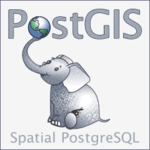PostGIS
 | |
| Developer(s) | Refractions Research, Paul Ramsey, Dave Blasby, Mark Cave-Ayland, Regina Obe, Sandro Santilli, Olivier Courtin, Nicklas Avén, Bborie Park, Pierre Racine, Daniel Baston, Darafei Praliaskouski, Raúl Marín Rodríguez, Kevin Neufeld, Jeff Lounsbury, Chris Hodgson, Jorge Arévalo, Mateusz Loskot, Norman Vine, Carl Anderson, Ralph Mason, Klaus Foerster, Bruno Wolff III, Markus Schaber |
|---|---|
| Initial release | April 19, 2001 |
| Stable release | |
| Repository |
|
| Operating system | Linux, Windows, Mac OS X, POSIX-compliant systems |
| Type | Geographic information system |
| License | GNU General Public License (version 2 or later) |
| Website |
postgis |
PostGIS (/ˈpoʊstdʒɪs/ POST-jis) is an open source software program that adds support for geographic objects to the PostgreSQL object-relational database. PostGIS follows the Simple Features for SQL specification from the Open Geospatial Consortium (OGC).
Technically PostGIS was implemented as a PostgreSQL's external extension.[2]
History
Refractions Research released the first version of PostGIS in 2001 under the GNU General Public License. After six release candidates, a stable "1.0" version followed on April 19, 2005.
In 2006 the OGC registered PostGIS as "implement[ing] the specified standard" for "Simple Features for SQL".[3]
Features
- Geometry types for Points, LineStrings, Polygons, MultiPoints, MultiLineStrings, MultiPolygons and GeometryCollections.
- Spatial predicates for determining the interactions of geometries using the 3x3 DE-9IM (provided by the GEOS software library).
- Spatial operators for determining geospatial measurements like area, distance, length and perimeter.
- Spatial operators for determining geospatial set operations, like union, difference, symmetric difference and buffers (provided by GEOS).
- R-tree-over-GiST (Generalized Search Tree) spatial indexes for high speed spatial querying.
- Index selectivity support, to provide high performance query plans for mixed spatial/non-spatial queries.
- For raster data, PostGIS WKT Raster (now integrated into PostGIS 2.0+ and renamed PostGIS Raster)
The PostGIS implementation is based on "light-weight" geometries and indexes optimized to reduce disk and memory footprint. Using light-weight geometries helps servers increase the amount of data migrated up from physical disk storage into RAM, improving query performance substantially.
PostGIS is registered as "implements the specified standard" for "Simple Features for SQL" by the OGC.[4] PostGIS has not been certified as compliant by the OGC.
Users
There are a large number of software products that can use PostGIS as a database backend, including:
- ArcGIS (via GISquirrel, ST-Links SpatialKit, ZigGIS, ArcSDE and other third-party connectors)
- Cadcorp SIS
- CartoDB
- CitySurf Globe
- GeoMedia (via third-party connectors)
- GeoServer
- GeoNetwork
- GRASS GIS (GPL)
- gvSIG (GPL)
- Kosmo (GPL)
- Manifold System
- MapInfo Professional
- Mapnik (LGPL)
- MapServer (BSD)
- MapGuide (LGPL)
- OpenJUMP (GPL)
- OpenStreetMap
- QGIS (GPL)
- SAGA GIS (GPL)
- TerraLib (LGPL)
- TerraView (GPL)
- uDig (LGPL)
- Uber (company) (dropped in 2016)
See also
- Well-known text and binary, descriptions of geospatial objects used within PostGIS
- DE-9IM, the Dimensionally Extended nine-Intersection Model used by PostGIS